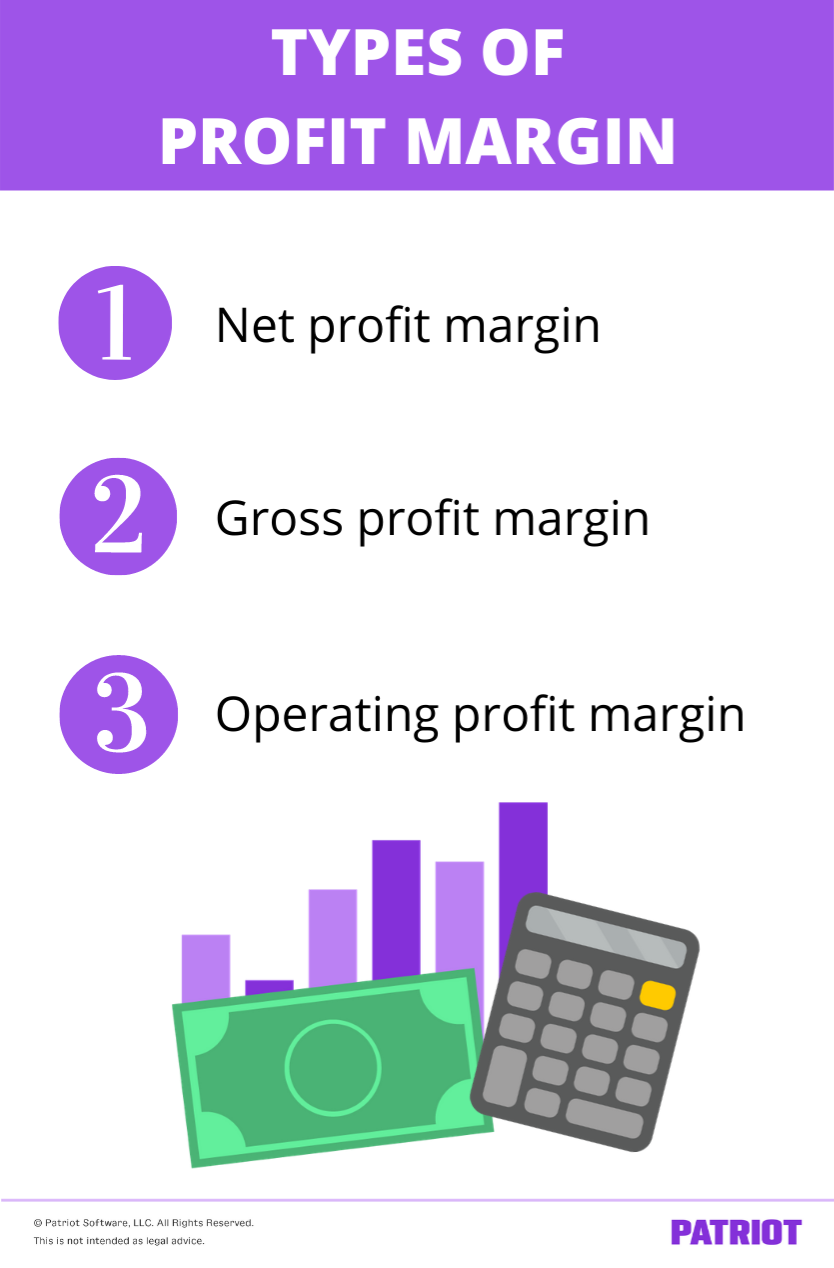To grow your business, you need to track financial information and measure performance. One metric you should be keeping an eye on is your business’s profit margin. Read on to learn how to determine profit margin for your company and ways to improve your margins.
What is profit margin?
Before you can dive into determining profit margin, you need to know what it is. Your business’s profit margin measures what percentage of revenue your business keeps after paying for outgoing expenses. You can calculate profit margin to see profitability for a specific time period.
In short, your profit margin or percentage lets you know how much profit your business has generated for each dollar of sale. For example, a 40% profit margin means you have a net income of $0.40 for each dollar of sales.
Tracking your profit margin can help you monitor your company’s health and make better business decisions in the future. Not to mention, it can help you flag and resolve financial issues more quickly. And, a good profit margin can make your business more attractive to investors.
There are a few ways to look at your profit margin:
- Net profit margin
- Gross profit margin
- Operating profit margin
Net profit margin
Your net profit margin, also referred to as your bottom line, is the total amount of revenue left over after all expenses and income is accounted for. This is your overall or “regular” profit margin. Your net profit margin looks at things like your cost of goods sold (COGS), operational expenses, payments on debts, taxes, one-time payments, and any income from investments.
Net profit margin shows your business’s overall ability to turn income into profit. In most cases, you use net profit margin to determine your company’s profitability and measure how much profit your business generates of your total revenue.
To calculate your business’s net profit margin, use the following formula:
Net Profit Margin = (Net Income / Revenue) X 100
If you don’t have your net income handy, you can also use the profit formula below to calculate your profit margin:
Net Profit Margin = [(Revenue – COGS – Operating Expenses – Other Expenses – Interest – Taxes) / Revenue] X 100
Gross profit margin
Gross profit margin measures the income left over after accounting for COGS. Your gross profit margin excludes overhead expenses, such as utilities or rent. Gross profit margin is one of the simplest profitability metrics because it defines profit as the income remaining after you account for cost of goods sold.
Typically, the gross profit margin equation is used to determine the profit margin of a single service or product, allowing you to see the amount of revenue you keep on each item. It is not usually used for calculating the profit margin for the business as a whole. You can use gross profit margin to tell you which items are the most and least profitable.
So, how do you calculate gross profit margin? To determine gross profit margin, use the following formula:
Gross Margin = [(Total Revenue – COGS) / Total Revenue] X 100
Operating profit margin
Operating profit margin takes into account all overhead, operating, administrative, and sales expenses necessary for day-to-day business operations. However, it does not include debt, taxes, and other non-operational expenses. Basically, your operating margin will show you your earnings from operating activities.
To find your business’s operating profit margin, use the formula below:
Operating Profit Margin = (Operating Income / Revenue) X 100

How to find profit margin (profit margin formula): 3 steps
As you can tell, there are a few ways to determine your profit margin. However, this depends on what type of profit margin (e.g., operating, gross, etc.) you want to calculate.
To determine your company’s overall profit margin, you’ll want to use the net profit margin formula. Use the formula below to calculate your business’s overall profit margin:
Profit Margin Calculation = (Net Income / Revenue) X 100
If you want to easily plug information into the above formula, use these three steps for determining profit margin:
- Determine your business’s net income (Revenue – Expenses)
- Divide your net income by your revenue (also called net sales)
- Multiply your total by 100 to get your profit margin percentage
How to calculate profit margin percentage: Examples
Ready to see how to compute profit margin in action? Take a look at some examples below on how to calculate overall/net profit margin as well as gross and operating margins.
Example 1: Net profit margin
For this example, let’s say you didn’t know what your business’s net income amount is. Because you don’t know the net income amount, use the following formula:
Net Profit Margin = [(Revenue – COGS – Operating Expenses – Other Expenses – Interest – Taxes) / Revenue] X 100
To find your net income, follow the first part of the formula, which is subtracting various expenses from your revenue. Here’s a breakdown of the expenses you need to subtract from your revenue:
- COGS: $4,000
- Operating expenses: $3,000
- Other expenses: $1,500
- Interest: $500
- Taxes: $1,000
Your revenue is $20,000. Your total expenses add up to $10,000. Plug your totals into the formula from above to find your net profit margin.
[($20,000 – $4,000 – $3,000 – $1,500 – $500 – $1,000) / $20,000] X 100
[($20,000 – $10,000) / $20,000] X 100
Your business’s net profit margin would be 50% or 0.50 [($10,000 / $20,000) X 100].
If you already know your net income amount, you can skip the step of subtracting your expenses from revenue and simply divide your net income by your revenue, then multiply the total by 100 (see other net profit margin formula listed).
Example 2: Gross profit margin
Say you want to find the gross profit margin on a certain product you offer. To find the gross profit margin, you need to know how much the item sells for (revenue) and how much it costs to make (COGS).
Say you sell a shirt for $25. It costs $15 dollars to make the shirt (COGS). To find your gross profit margin, plug your totals into the formula below:
Gross Margin = [(Total Revenue – COGS) / Total Revenue] X 100
Gross Margin = [($25 – $15) / $25] X 100
Your business’s gross profit margin is 40%, or 0.40. This means you make 40% on every shirt you sell.
Example 3: Operating profit margin
Let’s say you want to find your business’s operating profit margin. Your operating income is $10,000 and your revenue is $40,000. Plug your operating information into the operating profit margin formula.
Operating Profit Margin = (Operating Income / Revenue) X 100
Operating Profit Margin = ($10,000 / $40,000) X 100
Your company’s operating profit margin is 25% or 0.25.
Standard profit margins
Profit margins vary from industry to industry. A “good” profit margin for one company may be considered “bad” for another.
Your average profit margin depends on a few different factors. Some of these factors include the number of employees you have, business location, type of business, size, how you manage inventory, and your operating systems.
Because profit margins vary, you can’t compare yours to companies in different industries. So, what is a good profit margin? Take a look at some standard net and gross profit margins for various industries below:
| Industry | Net Profit Margin | Gross Profit Margin |
| Construction | 5% | 19% |
| Retail | 5% | 22% |
| Restaurants | 15% | 67% |
| Transportation | 19% | 47% |
| Auto Repair & Maintenance | 12% | 21% |
If you want to find out the average profit margin for your business and industry, compare yourself to similar small businesses or your competitors. That way, you get a more accurate picture of what your profit margin goals should be.
Ways to improve profit margin
Does your profit margin need a little lovin’? If so, don’t worry … you’re not alone. If you want to increase your business’s profit margin, you may just need to make a few adjustments. Ultimately, you want to lower costs and expenses and increase sales to improve your margin.
To help lower costs, you can:
- Optimize vendor relationships
- Look for alternative solutions to current processes
- Cut offerings that don’t do well or sell
- Reduce business and operating expenses
- Identify and eliminate waste
If you want to raise your sales, consider doing the following:
- Have a sale on old inventory
- Increase your prices accordingly
- Use upselling and cross-selling techniques
- Increase customer retention
- Improve inventory visibility
Searching for an easy way to track your business’s income and expenses? Patriot’s accounting software lets you streamline your books so you can get back to business. Try it for free today!
Have questions, comments, or concerns about this post? Like us on Facebook, and let’s get talking!
This article has been updated from its original publication date of August 31, 2017.
This is not intended as legal advice; for more information, please click here.
